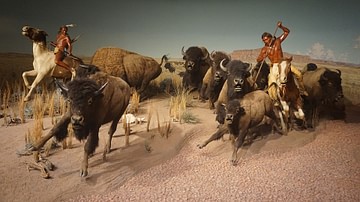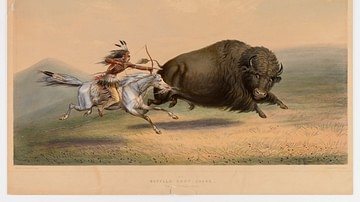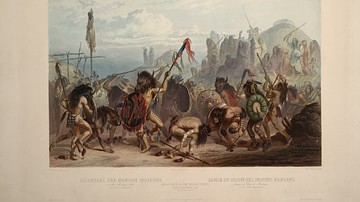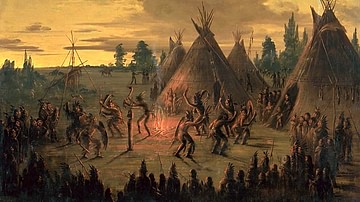White Buffalo Calf Woman (Ptesan-Wi) is a supernatural entity of the Sioux religion, who serves as an intermediary between Wakan Tanka (Great Mystery or Great Spirit) and the people. According to Sioux lore, she appeared to the people in the distant past to teach them how to reconnect and maintain a relationship with the Great Spirit.

Her name, Ptesan-Wi, means "White Buffalo Calf Woman." She is sometimes referenced as a Native North American goddess, sometimes as a spirit, sometimes as a 'spirit guide' and is also known as Pte-San Win-Yan, Sacred Woman, White Buffalo Woman, White She-Buffalo, and White Buffalo Maiden. As one of her symbols is the ceremonial pipe, she is sometimes referred to as the goddess of tobacco – though this association should be understood along the lines of how Native Americans have viewed and used tobacco, not how it is generally understood by non-natives in the modern era. She is also associated symbolically with the numbers 4 and 7 (4 being the number of days she spent among the Sioux, and 7 the number of sacred rites), and with the bison, eagle, hawk, buttercup, sage, and agate, and, further, she is seen as a divine force deterring and punishing rape while empowering women and encouraging devotion to the common good.
There are many variations on the story of Ptesan-Wi, but all seem to come from a single source, which tells of two Lakota Sioux hunters – one of noble spirit and the other selfish and lustful – who encounter a beautiful maiden in the wilderness. The lustful man tries to lay hands on her and is killed, while the noble man, who shows her proper respect, is sent by her to tell his people she is coming to visit them and how to prepare for her. The man does as he is told, and when she arrives, she instructs the people on the proper use of the chanunpa (ceremonial pipe), the lela wakan ("very sacred") bundle of tobacco, and the seven sacred rites they are to observe to honor and commune with Wakan Tanka. She then departs after telling the people that, as long as they observe the rituals she has taught, and maintain their relationship with the Great Spirit, they will endure and prosper.
The story of White Buffalo Calf Woman was, and is, central to Sioux religious belief and ritual, which, in accordance with one of the variations of her story, teaches she will return one day to restore balance and universal harmony. Drawing on her inspiration, the White Buffalo Calf Women's Society, founded in 1977 on the Rosebud Reservation of the Sioux Nation in South Dakota, is working daily to protect, educate, and empower people, especially women and children, through community outreach and programs. Other groups and activists continue to honor the Sacred Maiden in similar ways as they fight for justice and the preservation of the environment.

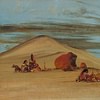
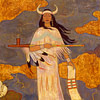
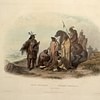


Twelve Stories of the Plains Indians
Seven Rites & Ceremonial Pipe
According to Sioux lore, White Buffalo Calf Woman appeared to the people at a time when they had forgotten how to pray and had lost touch with the Great Mystery, the Creator who had provided them with all good gifts. White Buffalo Woman came as an intermediary between Wakan Tanka and the people to remind them of who they were, of their relationship to the Creator, and to teach them how to maintain that relationship through the seven rites which would include the use of the ceremonial pipe. The pipe was to be smoked prior to and during the observance of the seven rites:
- Keeping of the Soul (Keeping and Releasing of the Soul)
- The Purification Rite
- Crying for a Vision
- The Sun Dance
- The Making of Relatives
- The Girl's Coming of Age
- The Throwing of the Ball
Scholar Larry J. Zimmerman explains the rites:
The first rite, the "keeping and releasing of the soul" is used to "keep" the soul of a dead person for a number of years until it is properly released, ensuring a proper return to the spirit world. The second ritual is the "sweat lodge", a purification rite. The third, "crying for a vision", lays down the ritual pattern of the Lakota vision quest. The fourth is the communal ceremony known as the Sun Dance. The fifth is the "making of relatives", a ritual joining of two friends into a sacred bond. The sixth is the girl's puberty ceremony. The final ritual is called "throwing the ball", a game representing Wakan Tanka and the attaining of wisdom. The ceremonies of the Lakota enacted [White Buffalo Calf Woman's] injunction to revere the Great Spirit. (237)
In observing these rituals, the pipe and sacred tobacco were used to elevate the soul and open communication between the people and their Creator. Zimmerman explains:
The holy woman demonstrated how to present the pipe to the Earth, the sky, and the sacred directions, before explaining that the circular stone bowl of the pipe, with its carving of a buffalo calf, represented Earth and all the four-footed animals that walked upon it. Its wooden stem, rising from the center of the bowl, stood for everything that grows and represented a direct link between the Earth and the sky. Twelve spotted eagle feathers hanging from the pipe represent all the creatures of the air. "Whenever you smoke this pipe," the woman said, "all these things join you, everything in the universe; all send their voices to Wakan Tanka, the Great Spirit. Whenever you pray with this pipe you pray for and with all things." (236)
According to Sioux belief (as well as other Native American tribal nations), all things in the universe are alive with spirit, and all are connected. The smoke from the pipe, first offered to Wakan Tanka, then the Earth, sky, directions, and the people, drew all together in communion. From the time White Buffalo Calf Woman gave the pipe to the Sioux, it has been carefully preserved and handed down from generation to generation. Lakota Sioux Spiritual leader Arvol Looking Horse (b. 1954) is presently the 19th keeper of the sacred pipe. In the story of White Buffalo Calf Woman (usually titled Origin of the Sioux Peace Pipe), she impresses upon the people the pipe's importance for the spiritual health and prosperity of the people and the world in general; an understanding that has been passed down to the present generation of Sioux with the pipe.
Text
The following story comes from Myths and Legends of the Sioux (first published in 1916) by Marie L. McLaughlin who, in her introduction to the book, writes:
In publishing these "Myths of the Sioux," I deem it proper to state that I am one-fourth Sioux blood…Having been born and reared in an Indian community, I at an early age acquired a thorough knowledge of the Sioux language, and having lived on Indian reservations for the past forty years in a position which brought me very near to the Indians, whose confidence I possessed, I have, therefore, had exceptional opportunities of learning the legends and folk-lore of the Sioux. (3)
McLaughlin's version of the story appears as The Legend of the White Buffalo Woman on the Akta Lakota Museum & Cultural Center site and as Origin of the Sioux Peace Pipe in Voices of the Winds: Native American Legends by Margot Edmonds and Ella Clark. Variations on the story, some adding the number of days White Buffalo Calf Woman spent among the Sioux, some other details, appear elsewhere (as does this version), but McLaughlin's tale seems to be the origin, in print at least, for the rest.
Long, long ago, their band chose two young and handsome Lakota men to find out where the Buffalo were. While the men were riding in the buffalo country, they saw someone in the distance walking toward them.
As always, they were on the watch for any enemy. So, they hid in some bushes and waited. At last, the figure came up the slope. To their surprise, the figure walking toward them was a woman. When she came closer, she stopped and looked at them. They knew she could see them, even in their hiding place. On her left arm, she carried what looked like a stick in a bundle of sagebrush. Her face was beautiful.
One of the men said, "She is more beautiful than anyone I have ever seen. I want her for my wife."
But the other man replied, "How dare you have such a thought? She is wondrously beautiful and holy, far above ordinary people."
Though still at a distance, the woman heard them talking. She laid down her bundle and spoke to them. "Come. What is it you wish?"
The man who had spoken first went up to her and laid his hands on her as if to claim her. At once, from somewhere above, there came a whirlwind. Then, there came a mist, which hid the man and the woman. When the mist cleared, the other man saw the woman with the bundle again on her arm. But his friend was a pile of bones at her feet.
The man stood silent in wonder and awe. Then, the beautiful woman spoke to him. "I am on a journey to your people. Among them is a good man whose name is Bull Walking Upright. I am coming to see him especially."
"Go on ahead of me and tell your people I am on my way. Ask them to move camp and to pitch their tents in a circle. Ask them to leave an opening in the circle, facing the north. In the center of the circle, make a large tipi, also facing the north. There I will meet Bull Walking Upright and his people."
The man saw to it that all her directions were followed. When she reached the camp, she removed the sagebrush from the gift she was carrying. The gift was a small pipe made of red stone. On it was carved the tiny outline of a buffalo calf.
She gave the pipe to Bull Walking Upright, and then she taught him the prayers he should pray to the Strong One Above. "When you pray to the Strong One Above, you must use this pipe in the ceremony. When you are hungry, unwrap the pipe and lay it bare in the air. Then, the Buffalo will come where the men can easily hunt and kill them so the children, the men and the women will have food and be happy."
The beautiful woman also told him how the people should behave to live peacefully together. She taught them the prayers they should say when praying to their Mother Earth. She told him how they should decorate themselves for ceremonies.
"The earth," she said, "is your mother. So, for special ceremonies, you will decorate yourselves as your mother does, in black and red, in brown and white. These are the colors of the Buffalo also."
"Above all else, remember this is a peace pipe I have given you. You will smoke it before all ceremonies. You will smoke it before making treaties. It will bring peaceful thoughts into your mind. If you use it when you pray to the Strong One Above and to Mother Earth, you will be sure to receive the blessings you ask."
When the woman had completed her message, she turned and slowly walked away. All the people watched her in awe. Outside the opening of the circle, she stopped for an instant and then lay down on the ground. She rose again in the form of a black buffalo cow. Again, she lay down and then arose in the form of a red buffalo cow. A third time she lay down and arose as a brown buffalo cow. The fourth and last time, she had the form of a spotlessly white buffalo cow. Then she walked toward the north into the distance and finally disappeared over a far-off hill.
Bull Walking Upright kept the peace pipe carefully wrapped most of the time. He called all his people together every little while, untied the bundle, and repeated the lessons the beautiful woman had taught him. And he used it in prayers and other ceremonies until he was more than one hundred years old.
When he became feeble, he held a great feast. There he gave the pipe and the lessons to Sunrise, a worthy man. Similarly, the pipe was passed down from generation to generation. "As long as the pipe is used," the beautiful woman had said, "Your people will live and will be happy. As soon as it is forgotten, the people will perish."
Conclusion
As noted, the story of White Buffalo Calf Woman is central to Sioux religious belief, but the above version is not the only one. In another, the maiden appears to a group of hunters at the mouth of a sacred cave, as described by scholars Yvonne Wakim Dennis et al.:
Lakota culture celebrates White Buffalo Calf Woman, and in one of the nation's earliest examples of oral literature, White Buffalo Calf Woman appears to a group of Lakota hunters at Wind Cave, Washu Niya, the breathing place. Washu Niya is named for the fog that emanates from the mouth of the cave and is considered to be the spot where all animals entered the world. After turning one of the hunters to dust for gazing upon her disrespectfully, White Buffalo Calf Woman imparts a message of respect for women before she gives the men the gift of the sacred pipe, upon which Lakota spirituality is centered: "On you [the men] it depends to be a strong help to the woman in the raising of children. Wakan Tanka smiles on the man who has a kind feeling for a woman." Sacred pipe bowls, representing a woman's womb, are shaped from red catlinite stone and often feature carvings of buffalo. The bowl is affixed to a wooden stem, representing the male. To this day, the birth of a rare female white buffalo calf is considered a miraculous omen of positive change and inspires visitors to travel long distances with offerings for the calf. (178-179)
In 1994, a white buffalo calf was born in Wisconsin and others have appeared since. Arvol Looking Horse performed the rite of the Four Directions honoring the birth of the Wisconsin calf (named "Miracle") and has done the same for the others. The appearance of the white buffalo calf presages the return of White Buffalo Calf Woman, but the Sioux are not waiting passively for her.
The members of the White Buffalo Calf Women's Society are at work every day in the interests of women and children while Sioux lawyers and activists, including Looking Horse, are fighting against the Dakota Access Pipeline, Keystone XL Pipeline, and other environmental threats to their land and safety as well as pursuing legal measures to win back their ancestral lands, especially the territory of the Black Hills, as well as addressing other issues. In doing so, they honor the promise made long ago to White Buffalo Calf Woman to remember their prayers through the seven rites, honor the Creator, and protect the created world for future generations.
